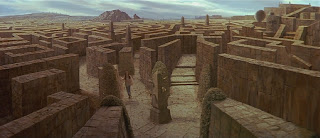Homer numbered hundreds of Cretan cities. Undoubtedly, in this issue was also some market towns, Crete is a city symbolic embodiment of the new world that is both dedicated to the gods and despots. This applies particularly to Knos. Mosaic found under the ruins of his allows us insight into the draft of a fortified town with a multi-story houses lined side by side. Plan of the city is just as complex as the layout of the Cretan palace so it can establish clear-cut plan matches the city and palace. At the same time as the match occurs, a new form: the labyrinth. Labyrinth is definitely a myth that derives from the shape of the old Cretan cities of which are now remaining only a very vague signs and sketches - but we assume that the maze depicted in a symbolic manner and the scenic Cretan tradition of transport networks through the earth and sea.
The City Palace, the palace that developed the town. We can fully admire the Knosu, unique city, the monument construction in Knosu Palace, residence of the ruler Minoja, the largest and also most famous buildings in Crete. Thanks to the research many individual components were found that have enabled the reconstruction of the upper floors. The current layout of the palace makes visible and understandable only the last period of its use, ie the peak of the Minoan culture from 1600th to 1400th BC.


No comments:
Post a Comment